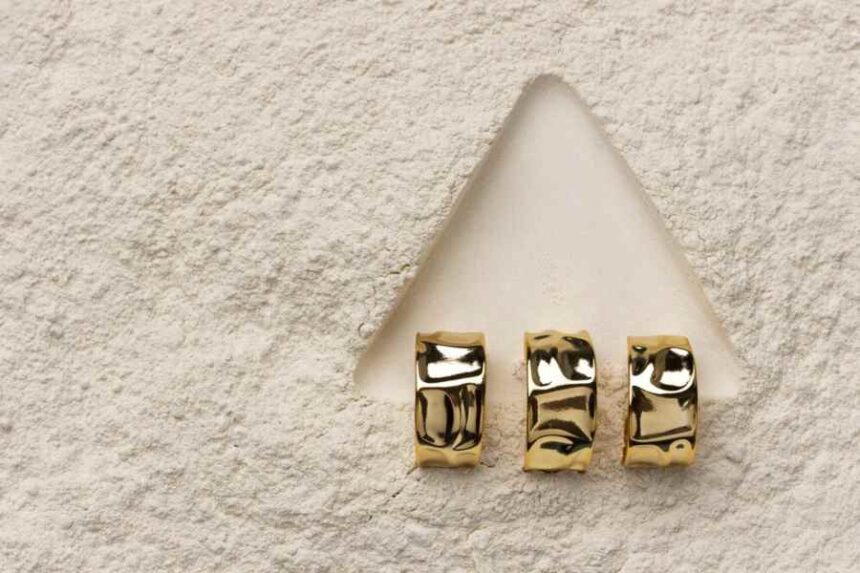I’ve been wearing my white gold wedding band for nearly five years now, and the question I get asked most often is whether it will tarnish over time. White gold simply catches the eye with its crisp, bright finish – quite different from traditional yellow gold pieces.
Many jewelry shoppers pick white gold for engagement rings and necklaces without fully understanding what they’re buying. After researching extensively for my own purchase, I discovered white gold isn’t what most people think it is.
Unlike yellow gold, which occurs naturally and sits right on the Periodic Table, white gold doesn’t exist in nature. Jewelers create it by mixing pure gold with other white metals in a process called alloying.
Manufacturers typically blend pure gold with nickel, zinc, silver, or palladium. Then they apply a rhodium coating for that mirror-like finish we associate with white gold.
Did you know white gold only became popular in the 1920s? It emerged as a budget-friendly stand-in for platinum during World War I when platinum demand skyrocketed.
Today, we still love white gold, especially for settings with diamonds. People choose it both for its appearance and quality, though many don’t realize what makes it special.
Can White Gold Tarnish?
The straightforward answer? No, white gold doesn’t tarnish. I remember panicking when I first noticed changes in my ring, but a local jeweler set me straight.
True tarnish happens through oxidation-reduction reactions when metals interact with elements in the air or environment. This creates that darkened layer we see on silver pieces.
White gold stays tarnish-free because gold itself has exceptional chemical stability. The alloy metals used in white gold generally resist chemical reactions well, preventing the surface degradation we associate with tarnish. I confirmed this when I had a custom gold pendant made for my mother’s birthday from Icecartel – the jeweler explained that whether crafted into pendants, rings, or earrings, white gold maintains this tarnish-resistant quality.
Here’s the catch, though – white gold jewelry absolutely can change color over time. This change isn’t tarnish but happens when the rhodium plating gradually wears away.
Understanding Rhodium Plating
I had no idea what rhodium was until my jeweler explained why my ring was losing its bright white shine. Nearly all white gold jewelry comes coated with rhodium, which belongs to the platinum family.
Rhodium creates that scratch-resistant, super reflective finish we love. It stands up to corrosion remarkably well. My jeweler explained that rhodium ranks as possibly the rarest and most valuable precious metal on earth – even more so than gold itself.
With daily wear, this rhodium coating gradually thins out. When this happens, you’ll see the actual white gold alloy underneath. This alloy often has a warmer, slightly yellowish tone compared to the bright white rhodium surface.
The confusion happens when people mistake this natural wearing process for tarnishing. In reality, your white gold piece remains perfectly intact – you’re just seeing its true colors as the coating fades.
Factors That Affect White Gold Jewelry
After noticing changes in my white gold pieces, I started researching what speeds up rhodium wear. Several everyday factors contribute to how quickly your white gold jewelry changes appearance:
Contact With Other Metals
I stopped wearing my white gold and yellow gold rings on adjacent fingers after learning rhodium plating gets damaged from touching softer metals, including other gold pieces. Even everyday objects like cutlery or metal handrails can accelerate wear on the rhodium layer.
My jeweler recommended avoiding stacking multiple rings together. The friction between different pieces speeds up rhodium deterioration significantly.
Daily Abrasion
Regular activities take a surprising toll on white gold jewelry. Contact with skin, clothing fabrics, and even food gradually wears down rhodium plating.
I noticed my ring’s finish changing faster after starting a desk job with constant typing. These seemingly minor movements create friction that slowly removes tiny amounts of the rhodium coating each day.
Chemical Exposure
I ruined a white gold bracelet before realizing household chemicals pose serious risks. Cleaning products, bleach, and even gentle detergents can damage rhodium plating permanently.
Now I always remove my white gold pieces before cleaning anything. Even mild hand soaps can affect the coating with regular exposure, as I discovered the hard way.
Chlorine Exposure
My sister-in-law’s white gold engagement ring lost its shine unusually quickly. The culprit? She swims daily in a chlorinated pool. Chlorine aggressively erodes rhodium plating and shortens jewelry lifespan dramatically.
Every jeweler I’ve consulted strongly advises removing white gold pieces before swimming in treated water. This simple step helps maintain the rhodium layer much longer.
Sweat Contact
The minerals in human sweat can damage rhodium plating – something I learned during summer months. While everyday wear poses minimal risk, heavy exercise significantly increases potential damage.
I started removing my white gold rings during workouts, which noticeably extended the time between re-plating visits. This small habit saves both the appearance of the jewelry and money on maintenance.
How Long Does Rhodium Plating Last?
When I bought my white gold engagement ring, nobody mentioned I’d need regular maintenance. Typically, rhodium plating lasts somewhere between twelve and eighteen months before needing refreshing.
This timeframe varies enormously depending on your lifestyle. My mother’s white gold pieces look almost new after years because she only wears them occasionally. My daily-wear ring needs replacing within eight months.
The type of jewelry matters tremendously too. Rings require more frequent care since hands constantly touch surfaces and objects. My white gold earrings have maintained their coating far longer with minimal signs of wear.
Maintaining White Gold’s Appearance
After spending considerably on white gold pieces, I’ve learned specific care routines help extend their beauty. These simple habits significantly prolong the time between costly re-plating services.
Remove Before Water Exposure
I made the mistake of wearing my white gold ring in the shower for months before realizing the damage this causes. Water contains minerals and chemicals that gradually deteriorate rhodium plating.
Even regular tap water may contain abrasive elements. Pool water, with its high chlorine content, poses even greater risks to white gold jewelry.
Avoid Cleaning Products
The fastest way I damaged a white gold necklace was wearing it while cleaning our apartment. Household cleaners contain harsh chemicals that immediately attack rhodium plating.
Even washing dishes presents surprising risks. The combination of cleaning agents and mechanical friction quickly wears away the protective coating.
Be Careful With Jewelry Combinations
Through trial and error, I discovered strategic jewelry wearing helps preserve white gold pieces. Avoid placing white gold rings next to other rings that might cause friction.
My grandmother cleverly dedicates her right hand exclusively for rhodium-plated white gold rings. This separation prevents metal-to-metal contact that accelerates wear.
Avoid Silver Cleaning Solutions
I once made the terrible mistake of using a silver cleaning solution on my white gold bracelet. The results were disastrous.
The fundamental differences between sterling silver and white gold make silver cleaners potentially harmful to white gold. These products can permanently damage rhodium plating and require professional restoration.
Exercise Caution During Activities
I learned to remove white gold jewelry before gardening, cooking, or sports after scratching my wedding band beyond repair. Activities involving hand use present significant risks to rhodium plating.
Taking preventative measures with luxury jewelry makes financial sense. Prevention costs far less than repairs or complete re-plating.
Re-plating White Gold Jewelry
After wearing white gold for years, I’ve accepted that re-plating represents a normal part of ownership. Understanding this process helps manage expectations and budget accordingly.
The Re-plating Process
My local jeweler completes the re-plating process surprisingly quickly. The entire procedure typically takes around 90 minutes from drop-off to pickup.
This efficiency allows busy customers to leave jewelry and return the same day. The convenience makes routine maintenance much easier to schedule than I initially feared.
Re-plating Costs
I’ve found re-plating costs vary widely depending on several factors. The quality of rhodium used, jeweler expertise, and specific jewelry characteristics all influence pricing.
Most services I’ve encountered charge between $30 and $150 per piece. This investment maintains the jewelry’s original appearance and protects the underlying white gold alloy from damage.
Re-plating Frequency
My white gold rings need replating roughly every year with daily wear. My necklaces and earrings typically go 2-3 years between services.
I’ve learned to trust professional jewelers who can recommend appropriate re-plating schedules based on individual wear patterns and jewelry types. Their experienced eyes spot rhodium wear before it becomes obvious.
Alternative White Metal Options
After dealing with rhodium maintenance, I researched alternative white metals. Several options provide similar appearances with different care requirements.
Platinum
My sister chose platinum for her wedding set specifically for its naturally white appearance that never needs plating. This metal maintains its color permanently without additional treatments.
Current platinum pricing has become increasingly competitive with gold. Many jewelers now recommend platinum for hassle-free long-term value, especially for daily-wear pieces.
Palladium
A jewelry designer friend introduced me to palladium as another naturally white option. This metal belongs to the platinum family but typically costs less.
Palladium resists tarnishing exceptionally well and maintains its appearance without special care. It offers excellent durability for frequently worn jewelry.
Sterling Silver
For casual pieces, I often choose silver for its significantly lower cost compared to white gold or platinum. Well-polished silver delivers remarkable shine.
Unlike white gold, silver genuinely does tarnish from environmental exposure. However, regular cleaning easily restores its brilliant appearance.
White Gold Facts vs. Myths
I’ve encountered numerous misconceptions about white gold that create unnecessary confusion. Understanding the facts helps make better purchasing decisions.
Myth: White Gold Turns Yellow Because It Tarnishes
The reality I discovered: white gold doesn’t tarnish at all. The yellowish appearance develops when rhodium plating wears away, revealing the natural white gold alloy beneath.
White gold alloys contain yellow gold mixed with white metals. The slightly warm undertone shows through gradually as the rhodium layer diminishes with normal wear.
Myth: White Gold Maintenance Is Difficult
After owning multiple white gold pieces, I’ve found maintenance relatively simple. Basic precautions effectively maintain appearance between professional services.
Proper storage and handling significantly extend rhodium plating life. The care requirements match those of most fine jewelry, requiring minimal special attention.
Myth: White Gold Always Contains Nickel
I avoided white gold initially due to nickel sensitivity until learning modern white gold often uses palladium instead. This change dramatically reduces allergy risks while maintaining the desired appearance.
Many jewelers now offer nickel-free white gold options. These alternatives provide identical beauty without health concerns for sensitive individuals.
Summary: Making the Right White Gold Choice
After years of wearing and researching white gold, I’ve found it offers exceptional beauty when properly maintained. Understanding its unique properties helps protect your investment.
Regular care significantly extends rhodium plating life. When needed, professional re-plating easily restores white gold’s original brilliant appearance.
The slight yellow tone that eventually appears with wear represents normal aging, not tarnishing. This natural process affects all white gold pieces eventually, much like leather develops a patina.
White gold continues its popularity as a jewelry metal for good reason. Its elegant appearance beautifully complements diamonds and other gemstones in ways yellow gold sometimes cannot.
With proper understanding and care, white gold jewelry provides decades of enjoyment. Simple precautions protect these valuable items for years of beautiful wear.




